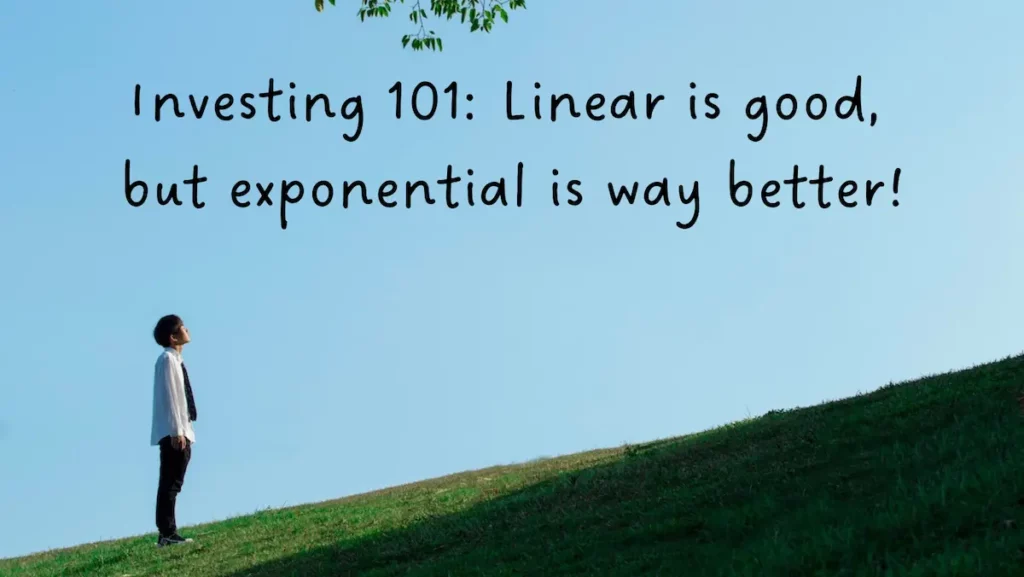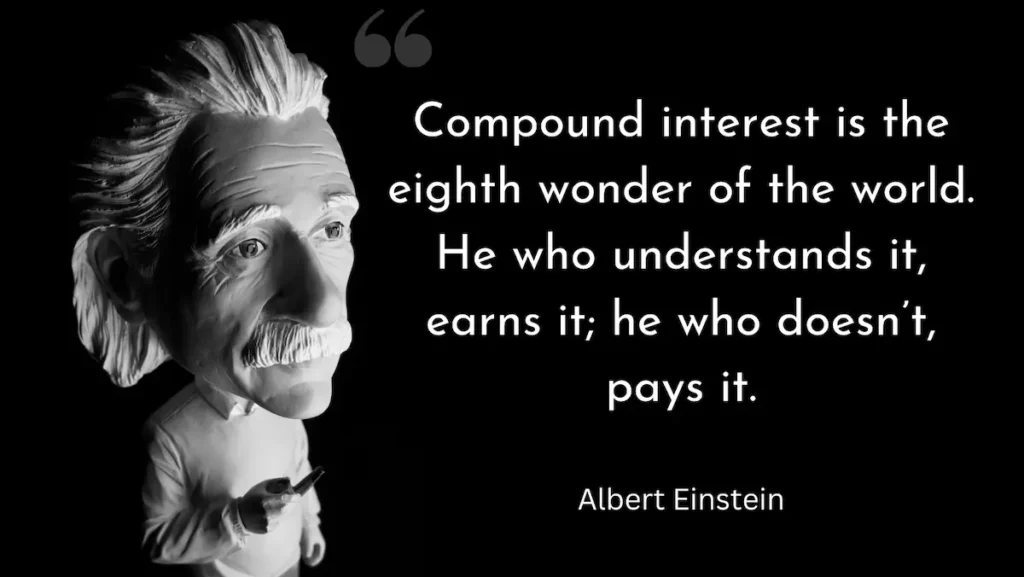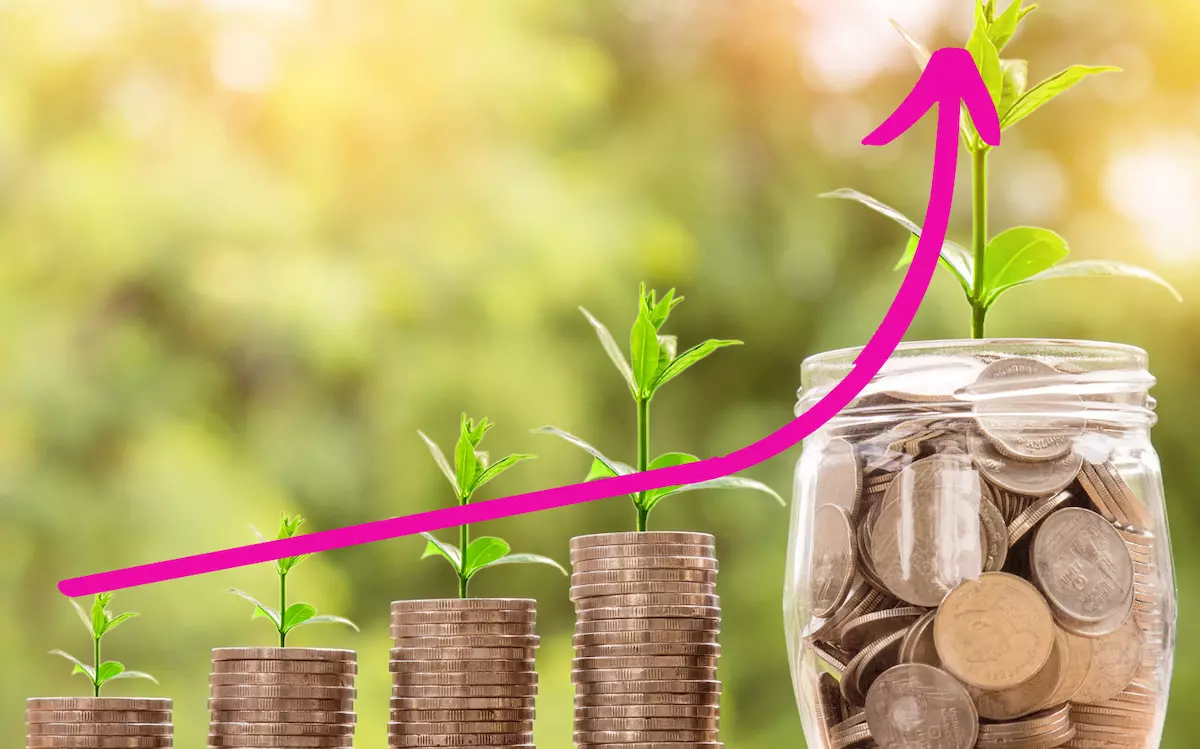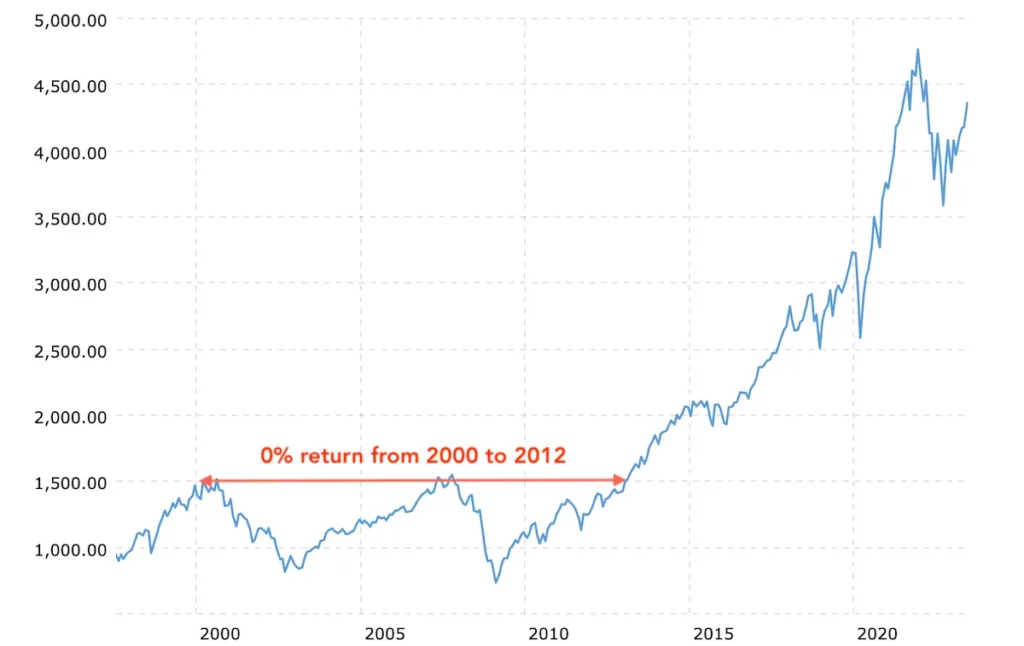If you could travel back in time and teach your younger self only one lesson, what would it be?
My answer: I would teach my younger self the power of the compound effect and how I could use it to get rich and stay rich.
Looking back on my younger days, I didn’t believe in investing in the stock market because I was none the wiser. I just thought the stock market was for gamblers. Boy, was I wrong!
This article is my attempt to enlighten anyone who is willing to listen and learn. Hopefully, after reading it, it’ll spur you to do what I didn’t do earlier. Here’s what I have in store for you:
- What is the Compound Effect
- How to Harness the Compound Effect to Grow Your Wealth
- The Compound Effect and the Stock Market
1. What is the Compound Effect
For most of us, whether we remember it or not, the first time we encountered the idea of the compound effect was likely in secondary school — either during math or science class. What is taught in school is that the compound effect is the trait of an exponential function.
Here’s an example of an exponential function in all its glory — the human population growth since 1,000 AD to the present day.

For a very long time, the world’s population had remained way below 1 billion and was creeping up at a snail’s pace (relatively speaking).
Then in the last 200 years, the world’s population started to skyrocket. This was mainly attributed to improvements in public health and sanitation, causing death rates to drop significantly.
The 1 billion mark was breached and the numbers have exploded to more than 8 billion in no time. Think about it, the world’s population went from 1 billion to 8 billion in about 200 years or so. That’s equivalent to a blink of an eye if you were to consider that modern humans originated hundreds of thousands of years ago.
That’s exponential growth for you. It gradually increases at the start and all seems normal… then boom!
Exponential growth or the compound effect is found throughout nature (not just human population growth), from bacteria growth, to viral pandemics, to the formation of a tsunami wave travelling inland.
Many financial experts call the compound effect “the snowball effect” — where a small snowball rolling down a snow-covered hill gets larger and larger and eventually turns into a mammoth snow bolder by the time it reaches the foot of the hill. The analogy illustrates how a small initial investment can snowball into millions over time (if managed well).
2. How to Harness the Compound Effect to Grow Your Wealth
Now that we are better acquainted with the compound effect, the next question is: how does it work on money?
Well, it’s based on something called compound interest. Albert Einstein once said, “Compound interest is the eighth wonder of the world. He who understands it, earns it; he who doesn’t, pays it.”
I don’t know about you, but I’m absolutely certain that I would like to earn compound interest, rather than pay it. To understand compound interest, let’s begin with non-compounding interest (aka simple interest).
I’m absolutely certain that I would like to earn compound interest, rather than pay it.
How Simple Interest Works
Let’s say you invest $1,000 at 4% interest per annum. You leave your principal of $1,000 untouched for 10 years and put the interest earned every year into a cookie jar.
| Year | Interest | Accrued Interest | Balance |
|---|---|---|---|
| 0 | $0.00 | $0.00 | $1,000.00 |
| 1 | $40.00 | $40.00 | $1,040.00 |
| 2 | $40.00 | $80.00 | $1,080.00 |
| 3 | $40.00 | $120.00 | $1,120.00 |
| 4 | $40.00 | $160.00 | $1,160.00 |
| 5 | $40.00 | $200.00 | $1,200.00 |
| 6 | $40.00 | $240.00 | $1,240.00 |
| 7 | $40.00 | $280.00 | $1,280.00 |
| 8 | $40.00 | $320.00 | $1,320.00 |
| 9 | $40.00 | $360.00 | $1,360.00 |
| 10 | $40.00 | $400.00 | $1,400.00 |
Mathematically, earning simple interest behaves like a linear function — think of your money increasing gradually like a gentle up-sloping hill.
The amount of interest you earn every year is fixed at $40. So at the end of 10 years, you would have accrued $400 ($40 x 10) of interest in your cookie jar. Adding everything up, your 10th year balance would be $1,400.
Of course, earning simple interest is better than stuffing your money under the mattress. Buying government bonds (and holding till maturity) or putting your cash into a time or fixed deposit are common ways to earn simple interest.
The downside of simple interest is that the interest earned is fixed. Yes, the interest doesn’t go down, but neither does it go up. If you were to factor in 2% to 3% inflation per annum, the money you have accumulated (principal + interest) will technically be worth less in 10 years’ time.
In other words, all else being equal, if you just earn simple interest, you will actually be poorer in the future! Not ideal for wealth building or even wealth preservation.
So what’s better than simple interest? Yes, you guessed it — compound interest!

How Compound Interest Works
This time, everything else remains the same, except that you re-invest the interest you earn every year. No more putting the interest earned into a cookie jar. Here’s how your account balance would look like:
| Year | Interest | Accrued Interest | Balance |
|---|---|---|---|
| 0 | $0.00 | $0.00 | $1,000.00 |
| 1 | $40.00 | $40.00 | $1,040.00 |
| 2 | $41.60 | $81.60 | $1,081.60 |
| 3 | $43.26 | $124.86 | $1,124.86 |
| 4 | $44.99 | $169.86 | $1,169.86 |
| 5 | $46.79 | $216.65 | $1,216.65 |
| 6 | $48.67 | $265.32 | $1,265.32 |
| 7 | $50.61 | $315.93 | $1,315.93 |
| 8 | $52.64 | $368.57 | $1,368.57 |
| 9 | $54.74 | $423.31 | $1,423.31 |
| 10 | $56.93 | $480.24 | $1,480.24 |
As you are now earning interest on the interest from the previous year (not just on the principal), the amount of interest you earn grows year after year. This will also allow you to at least keep pace with inflation and hopefully preserve your wealth.
Your account balance at the end of the 10th year is now at $1,480.24. Compared to simple interest, that’s a 20% increase in interest earned over 10 years. And the increase will get larger and larger over time.
Another way to think about it — your money is now like a living organism. Without any human intervention, your money keeps growing organically, i.e. exponentially. This is what it truly means to make money from money, and that’s exactly what Einstein was referring to as the eighth wonder of the world.
But let’s say you are not satisfied with preserving your wealth and want to get rich quicker. You want to retire earlier. Is there anything else you can do to harness the compound effect to reach your financial goals earlier? The answer is: a big fat yes!

How to Supercharge the Compound Effect
Let’s take a look at the mathematical formula for compound interest:
Total amount (i.e. the balance) = P(1 + r/100)n
Where P is the principal, r is the compounding interest rate in %, and n represents the number of times the amount was compounded.
What the formula essentially spells out is that we have only three ways to accelerate our investment return:
- increase the principal,
- increase the interest rate, and/or
- increase the tenure.
With regards to (3) the number of times your investment gets compounded depends mainly on the tenure or time horizon of your investment. The more years, the more times your money compounds, the more you will have. Needless to say, the younger you start investing, the better. In fact, the best time to start investing was yesterday!
Then we have (2) the interest rate. This is where most investors try their best to squeeze out as much as possible. The higher the yield, the better the returns, yes? Unfortunately, it’s not that simple. Believe me, I wish it was. In the investing world, a key concept to learn is that the higher the returns, the greater the risk.
Note: To a large extent, interest rates are not within our control and depends on the economic and financial environment. In fact, interest rates around the world are essentially dictated by central banks.
This brings us to (1) the principal amount — your investment capital, your seed money. This is probably the best way to supercharge the compound effect without additional risk.
The secret to boosting your wealth is that you do NOT have to do it all at once. You don’t need to start off with say $100,000 or even $10,000. The compound effect will still work its magic starting small and adding to it bit by bit over time. Here’s what I mean.
Continuing from our previous scenario, instead of just starting with a $1,000 investment and leaving it untouched, you now begin to consistently contribute an additional $100 every month from the start. And like the previous scenario, your balance is compounded at year end.
| Year | Contribution | Interest | Total Contribution | Accrued Interest | Balance |
|---|---|---|---|---|---|
| 0 | $2,200.00 | $0.00 | $2,200.00 | $0.00 | $2,200.00 |
| 1 | $1,200.00 | $88.00 | $3,400.00 | $88.00 | $3,488.00 |
| 2 | $1,200.00 | $139.52 | $4,600.00 | $227.52 | $4,827.52 |
| 3 | $1,200.00 | $193.10 | $5,800.00 | $420.62 | $6,220.62 |
| 4 | $1,200.00 | $248.82 | $7,000.00 | $669.45 | $7,669.45 |
| 5 | $1,200.00 | $306.78 | $8,200.00 | $976.22 | $9,176.22 |
| 6 | $1,200.00 | $367.05 | $9,400.00 | $1,343.27 | $10,743.27 |
| 7 | $1,200.00 | $429.73 | $10,600.00 | $1,773.00 | $12,373.00 |
| 8 | $1,200.00 | $494.92 | $11,800.00 | $2,267.92 | $14,067.92 |
| 9 | $1,200.00 | $562.72 | $13,000.00 | $2,830.64 | $15,830.64 |
| 10 | $1,200.00 | $633.23 | $14,200.00 | $3,463.87 | $17,663.87 |
Look at the massive difference the extra $100/month contribution made. Over 10 years, you have now accrued $3,463.87 of interest which will continue to snowball over time.
Of course, your returns would be higher if you had started with $13,000 ($1,000 + $1,200 x 10) and compound that amount for 10 years. But in reality, how many of us have a large sum of money lying around doing nothing?
The moral of the story: start investing and harnessing the compound effect as soon as you can. Time is of the essence. You don’t need a large lump sum to start investing. You can always start small, contribute consistently and compound your returns along the way. Believe me, you’ll be glad you started earlier rather than later. Numbers don’t lie.

Check out: Tame Your Emotions: Let Your Wealth Compound Uninterrupted
3. The Compound Effect and the Stock Market
When I first learned about the compound effect of investing, I immediately thought to myself that I needed to start ASAP! But then I thought again: it can’t be that simple. Will it actually work on the stock market? Prices seem high now, maybe I should wait for a correction? But what if prices don’t come down?
That was another lesson I learned the hard way: never try to time the market. As Ken Fisher once said, “Time in the market beats timing the market.” So what is the investing strategy that doesn’t require you to time the market and lets the compound effect do all the heavy lifting for you?
It’s called dollar cost averaging or DCA. DCA is exactly like the last scenario discussed above — where you consistently make monthly contributions (e.g. $100/month) to your investment account. Regardless of whether prices go up or down, you continuously invest without fail.
What DCA entails is that when prices dip, you buy more shares at lower prices. When prices escalate, you buy less shares at higher prices. Over the course of time as the stock market continues to fluctuate, with DCA the average price of the shares you have accumulated will average out nicely to yield positive compounding returns in the long run.
As Ken Fisher once said, “Time in the market beats timing the market.”
But… (here comes the “but”) wouldn’t DCA only work if the long term trend of the stock market was up? What if it doesn’t go up anymore? What if it just hobbles along, not making any new highs ever again?
Here comes the kicker. This is what I wished I had told my younger self: keep investing and stay invested because the compound effect works even if the stock market doesn’t keep going up.
Even if the total return of the stock market was zero over 10 years or 20 years or however many years, with a well executed DCA investment plan, you will still be able to harness the compound effect to grow your wealth. Skeptical? I was too… so let’s put this theory to the test.
This time, instead of using a fixed interest rate of 4% from a hypothetical investment account, let’s backtest our DCA investment plan on the S&P 500 index. (I’ve written extensively about investing in index funds that track the S&P 500 index previously and won’t expand on it here.)
Here’s a segment of the S&P 500 index historical chart:
You would notice that the S&P 500 was basically flat from 2000 to 2012. Thus, if you had made a lump sum investment at the beginning of 2000 and held it till the end of 2012, you would not have made a single dime for 12 years!
The market only started trending upwards in 2013 and took off like a rocket after that. Needless to say, we’re not going to backtest using this post-2013 period.
The real test is: will DCA work if you had invested $1,000 into the SPDR S&P 500 ETF (SPY) in Jan 2000 and continued to contribute $100 every month consistently for 10 years? What would your balance be at the end of 2010?
Here is the annual summary (backtester results):
| Year | Inflation | Contribution | Return | Total Contribution | Balance |
|---|---|---|---|---|---|
| 2000 | 3.39% | $2,200.00 | -9.73% | $2,200.00 | $2,045.00 |
| 2001 | 1.55% | $1,200.00 | -11.75% | $3,400.00 | $3,034.00 |
| 2002 | 2.38% | $1,200.00 | -21.59% | $4,600.00 | $3,546.00 |
| 2003 | 1.88% | $1,200.00 | 28.18% | $5,800.00 | $6,073.00 |
| 2004 | 3.26% | $1,200.00 | 10.70% | $7,000.00 | $8,171.00 |
| 2005 | 3.42% | $1,200.00 | 4.83% | $8,200.00 | $10,015.00 |
| 2006 | 2.54% | $1,200.00 | 15.85% | $9,400.00 | $13,163.00 |
| 2007 | 4.08% | $1,200.00 | 5.14% | $10,600.00 | $15,317.00 |
| 2008 | 0.09% | $1,200.00 | -36.81% | $11,800.00 | $10,863.00 |
| 2009 | 2.72% | $1,200.00 | 26.36% | $13,000.00 | $15,571.00 |
| 2010 | 1.50% | $1,200.00 | 15.06% | $14,200.00 | $19,667.00 |
Mind blown? I know mine was. Even with the S&P 500 moving side ways, with 4 years of negative returns (2008 was the worst), you would still come out on top with a balance of $19,667.00 in 2010. That’s the eighth wonder at work in real life!
Check out: Understanding Index Funds: Does the Tortoise Really Win? | Beyond Borders: Why Invest in a Global Index Fund
Caveat: Please don’t just randomly apply DCA to any stock or fund out there and assume it will work like a charm. If you get negative returns for 10 straight years, you will solely be disappointed. In other words, DCA and the compound effect will work its magic so long as the stock or fund isn’t on a permanent decline. So please do your due diligence and only invest in value stocks or funds. Also, the scenarios used does not include taxes, fees, etc. so factor those into your calculations if applicable.
If I had known this fact, I would have started investing a hell lot earlier! I hope you have been enlightened by the force of the compound effect. As Master Yoda would have told me, “A while it took, but learning you are.” May the compounding force be with you.
You may also like: How We Achieved FIRE in 7 Years | Unlock Your Future: 5 Reasons to Plan for Early Retirement | 7 Levels of Wealth: A Different Way to Think About Money | How 3 Investors from Different Continents Grow their Wealth


